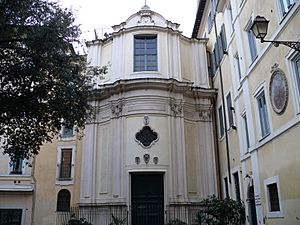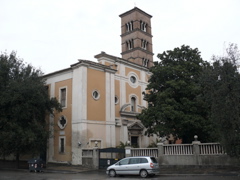Filippo Raguzzini facts for kids
Filippo Raguzzini (born July 19, 1690 – died February 21, 1771) was a talented Italian architect. He is most famous for the many buildings he designed and built when Pope Benedict XIII was in charge.
Contents
Filippo Raguzzini's Life and Work
Early Life and Rise to Fame
Filippo Raguzzini was born in Naples, a city in Italy. His family worked with stone, so he likely learned about building from a young age. We don't know much about his early years.
However, after a big earthquake hit the city of Benevento in 1702, Raguzzini was called there to help rebuild. This was a very important moment for him. In Benevento, he met Pietro Francesco Orsini. Orsini was the archbishop there for many years and later became Pope Benedict XIII in 1724. Meeting Orsini was key to Raguzzini's future career.
Some of his early works in Benevento might include the San Gennaro chapel (around 1710). Later, after Orsini became pope, Raguzzini designed two more churches in Benevento: San Filippo (1724–1727) and San Bartolomeo (finished in 1729).
Working for the Pope in Rome
Once Pietro Francesco Orsini became Pope Benedict XIII, Raguzzini moved to Rome. His career quickly took off! He received many important awards and titles. In 1725, he was made a Knight of the Golden Spur. By 1727, he was part of the important Accademia di San Luca, a famous art academy.
Because the Pope supported him so much, Raguzzini ended up holding almost every major public building job in Rome. He even took over some roles from an older, well-known architect named Alessandro Specchi. Raguzzini became the city architect, the architect for water and roads, and the architect for the Pope's own palaces. He held these jobs from 1728 onwards.
Big Projects in Rome
Pope Benedict XIII's time as pope didn't have a lot of money for huge building projects. This was because of some money problems in the government. So, not many new, large buildings were started.
However, Raguzzini still managed to complete some very important projects in Rome:
- The Ospedale di San Gallicano (a hospital) in Trastevere (1724–1726).
- The church of Santa Maria della Quercia (1727–1731).
- The redesign of Piazza Sant'Ignazio (1727–1735).
Santa Maria della Quercia Church
The church of Santa Maria della Quercia was built for the butchers' guild (a group of people working in the same trade) in Rome. Pope Benedict XIII himself seemed to support its construction. The church was named after a special image kept in Viterbo. Since the Pope was a Dominican monk, he was very interested in this church.
Even though it has been updated over time, this church is a wonderful example of the building style from the 1720s and 1730s. It's one of the few churches from the early 1700s in Rome that was built from scratch and designed by just one person.
Piazza Sant'Ignazio Square
Piazza Sant'Ignazio is a famous square surrounded by five buildings where government workers lived. It's known for its interesting oval shapes and clever design, which looks a bit like a theater stage.
When people walk from the nearby Piazza di Pietra, they suddenly find themselves in Piazza Sant'Ignazio. It feels like they've just walked onto a stage, facing the grand church. The buildings are beautiful, but the design also changes how the church and square relate to each other. Raguzzini made the square itself feel very lively and exciting, almost as important as the church.
Other Works and Later Years
Raguzzini also worked on many smaller projects during this time. These included:
- Renovating chapels in churches like San Domenico and Santa Maria sopra Minerva (1724–1726).
- Restoring the church and convent of San Sisto Vecchio (finished 1727).
- Doing minor work in famous places like the Sistine Chapel of Santa Maria Maggiore (1725), San Giovanni in Laterano (1726), and St. Peter's Basilica (1726).
- Restoring the main altar in San Simeone Profeta (1724).
- Making the convent next to Santa Maria in Campitelli bigger (1724).
- Building the Casino Lercari in Albano, outside Rome.
After Pope Benedict XIII, his main supporter, passed away in 1730, Raguzzini faced some difficulties. Many people who had come to Rome with the Pope were removed from their positions. Raguzzini was even arrested for a short time in 1731.
Although he lost many of his official jobs, Raguzzini fought in court and managed to get many of them back. In 1749, he was given a special title, which showed that he was officially back in good standing. He didn't design many new buildings after the mid-1730s, but his name still appeared in official city records. He passed away in Rome.
|
See also
 In Spanish: Filippo Raguzzini para niños
In Spanish: Filippo Raguzzini para niños




